Introduction
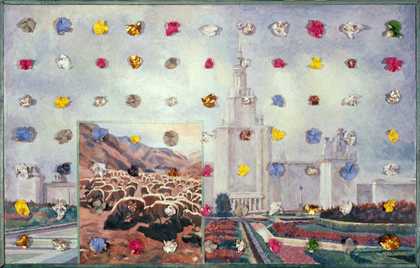
Ilya Kabakov Holiday #1 1987 Tsukanov Family Foundation © Ilya Kabakov
Photo Courtesy of the Artists
Ilya and Emilia Kabakov are amongst the most celebrated artists of their generation, widely known as pioneers of installation art.
Ilya Kabakov was born in 1933 in Dnepropetrovsk (now Dnipro) in Ukraine, formerly part of the Soviet Union. When he was eight, he moved to Moscow with his mother. He studied at the Art School of Moscow, and at the V.I. Surikov Art Institute.
Artists in the Soviet Union were obliged to follow the officially approved style, Socialist Realism. Wanting to retain his independence, Ilya supported himself as a children’s book illustrator from 1955 to 1987, while continuing to make his own paintings and drawings. As an ‘unofficial artist’, he worked in the privacy of his Moscow attic studio, showing his art only to a close circle of artists and intellectuals.
Ilya was not permitted to travel outside the Soviet Union until 1987, when he was offered a fellowship at the Graz Kunstverein, Austria. The following year he visited New York, and resumed contact with Emilia Lekach. Born in 1945, Emilia trained as a classical pianist at Music College in Irkutsk, and studied Spanish Language and Literature at Moscow University before emigrating to the United States in 1973. Ilya and Emilia began their artistic partnership in the late 1980s, and were married in 1992. Together, they have produced a prolific output of immersive installations and other conceptual works addressing ideas of utopia, dreams and fear, to reflect on the universal human condition.
Ilya and Emilia Kabakov have collaborated together since 1989. Works created before this date, by Ilya only, are indicated as such in the corresponding captions.
Room One

Ilya Kabakov Soccer Player 1964 Private Collection © Ilya Kabakov
Photo Courtesy of the Artists
Ilya’s early works explore the possibility of drawing and painting as conceptual media. They encompass a range of contrasting styles, from post-impressionism to abstraction, to the incorporation of text and found objects.
Having chosen not to be a state-approved fine artist, Ilya worked clandestinely. Sourcing materials was a challenge. Many of his early paintings are rendered on plywood or Masonite, a type of hardboard that is often used in the construction of walls and floors. The use of these cheap materials emphasises ideas rather than craftsmanship, and sets Ilya’s art firmly apart from the official Soviet artists.
A number of works introduce fictional characters. In a society where individuals were required to conform to the ideals of Soviet ideology, Ilya took to assuming pseudonyms and personae in his art. The humble, downtrodden figures who often appear in the Kabakovs’ work recall the tradition of Russian writers such as Gogol, Dostoevsky and Chekhov.
Room Two
Artistic experimentation was permitted for only a brief period after the Bolshevik Revolution of 1917. In the 1930s Socialist Realism was established as the approved artistic style of the Soviet Union. Painters were expected to produce idealised and determinedly optimistic portrayals of proletarian life. In Ilya’s paintings, Socialist Realism is ironically questioned. ‘We wanted to analyse the language of Soviet civilisation, the banal everyday language of the system,’ he has said. ‘We felt like observers in our own country, like ethnologists … but were also part of that life’.
Tested! 1981 is based on a work by a now forgotten artist from the 1930s, revealing the falsehood of this visual language. A woman whose political allegiances have been questioned has her party membership card returned. What would have been a cruel and traumatic experience is presented here as an occasion for celebration and joy.
Room Three
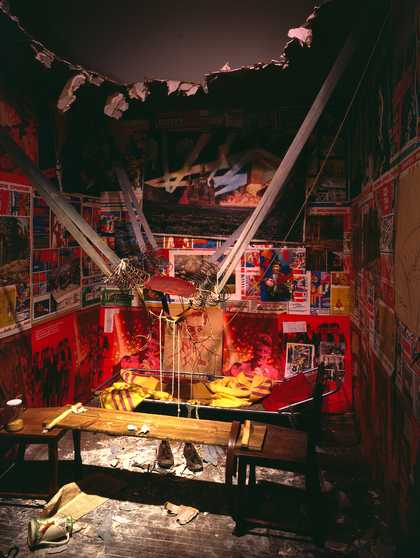
Ilya Kabakov The Man Who Flew Into Space From His Apartment 1985 Centre Georges Pompidou, Paris. Musée national d'art moderne/Centre de Création industrielle. Purchase, 1990 © Ilya & Emilia Kabakov
In 1985 Ilya created The Man Who Flew Into Space from His Apartment in his Moscow studio. It was his first whole room, or ‘total’ installation, a carefully choreographed staging of objects, lighting and text that immerses the viewer within the artwork.
Like the other two installations in this room, it presents a fictional narrative that takes place in the confines of a communal apartment – a form of domestic residence that emerged during the Soviet Union to deal with the shortage of housing in urban areas. Multiple households were forced to share the same cooking and washing facilities in often cramped conditions. For Ilya, the Soviet communal apartment is emblematic of the way in which the individual is exhibited and exposed to the gaze of others. The title character of The Man Who Flew Into Space from His Apartment finds a way to escape from this oppressive, everyday reality.
Room Four
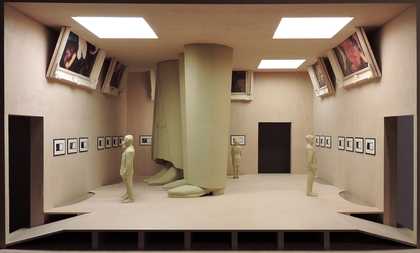
Ilya and Emilia Kabakov Where is Our Place? Private Collection © Ilya and Emilia Kabakov Photo Courtesy of the Artist
The sculptural installations Trousers in the Corner 1989 and I Catch the Little White Men 1990 both feature minuscule paper cut-out figures. According to Ilya, these ‘little white men’ are the inhabitants of a parallel world who can occasionally be glimpsed by human eyes. The tiny figures are just one example of the subversions of perspective and scale that appear throughout the Kabakovs’ work, perhaps reflecting the ways in which individuals are elevated and forgotten in historical records.
Concerns with scale and perception are also present in Ilya and Emilia’s models for the realised and unrealised installations Where is Our Place? 2002/2017 and The Vertical Opera (Guggenheim) 1998/2008. Both works draw upon the idea of the museum as a site of cultural authority, shaping our understanding of history, art, and society as a whole.
Room Five

Ilya Kabakov Three Nights 1989 Private Collection © Ilya Kabakov
Photo Courtesy of the Artists
The limits of visual perception are explored in Three Nights 1989. The three large paintings all relate to the theme of night, whether it be a starry sky or a nocturnal insect. However, they are placed behind a large screen, allowing only a partial view of each work. Viewers must look through monoculars, which are directed at small apertures through which magnified images of little white men can be seen.
With its emphasis on preventing and enabling different ways of looking, Ilya has linked this work to two irreconcilable types of knowledge. He contrasts the information that you can learn from conversations or books, which can be broken down and analysed, and the mystical revelations that ‘descend upon you’, which can be almost impossible to comprehend or communicate to others.
Room Six
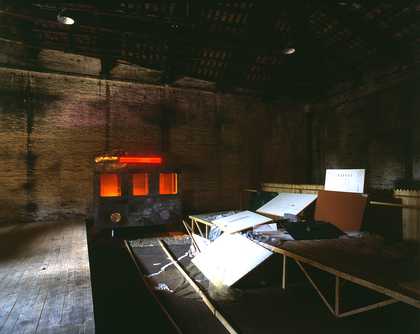
Ilya and Emilia Kabakov Not Everyone Will Be Taken Into the Future 2001 Private Collection courtesy of MAK –Österreichisches Museum für angewandte Kunst/Gegenwartskunst (tbc) © Ilya and Emilia Kabakov
Photo Courtesy of the Artists
Not Everyone Will Be Taken Into the Future was the title of a 1983 essay about the Russian artist Kazimir Malevich, which Ilya contributed to A-YA, a journal of unofficial Russian art that was published in Paris. He imagines Malevich as a charismatic visionary, leading his people upwards into the future. He then remembers his art school, where the most deserving pupils were selected to go to the Young Pioneer camp, while the rest were left behind. Ilya reflects that some artists will go forward and become part of the history of art, but many others will be forgotten.
In the installation of the same name, made by Ilya and Emilia in 2001, a train is already leaving the platform, carrying all of those selected to be part of the future. Discarded canvases bring to mind all of the artists abandoned to obscurity, whether they have fallen out of favour with a political regime or simply become unfashionable. As the art world is so focused on keeping up with the present moment, the Kabakovs ask, ‘What will happen to these works tomorrow?’
Room Seven
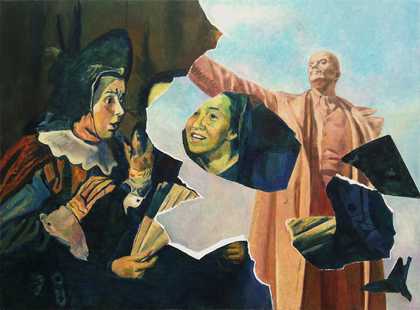
Ilya and Emilia Kabakov The Appearance of the Collage # 10 2012 Private Collection © Ilya and Emilia Kabakov
Photo Courtesy of the Artists
Since the early 2000s, the Kabakovs have returned to exhibiting paintings in their own right, not always as part of an installation. Many of these works explore themes of memory and forgetting, often relating to the dissolution of the Soviet Union in 1991.
In Under the Snow #2 2004, fragmentary images of parades and heroic soldiers are visible among swathes of white, suggesting a historical past buried beneath the blank surface of the present day. In other works, scenes resembling Soviet paintings seem to be layered on top of each other, their edges like the ripped pieces of a hurriedly assembled collage. The relation between the different elements is ambiguous, and it can be hard to tell which represent the background and which the foreground. The series Two Times conflates imagery reminiscent of seventeenth-century painting with glimpses of everyday Soviet life, as if art history were intertwined with the Kabakovs’ early memories.
Room Eight
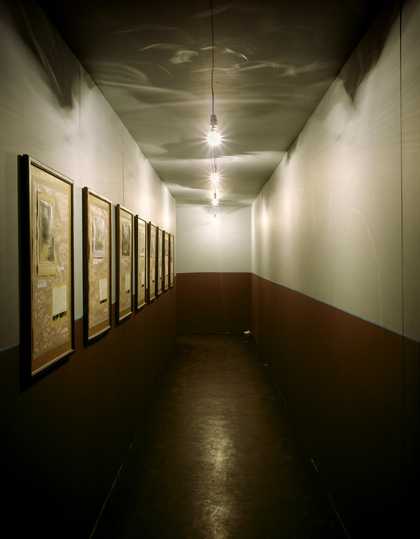
Ilya Kabakov
Labyrinth (My Mother’s Album) (1990)
Tate
‘When I think about that world in which my mother’s life passed’, Ilya has said, ‘what arises in my imagination is a long and semi-dark corridor which is twisted like a labyrinth, where behind each new turn, behind each bend, there is not a bright exit glimmering in the distance, but just the same grubby floor, the same grey, dusty, poorly painted walls illuminated by weak, 40-watt light bulbs.’
Labyrinth (My Mother’s Album) 1990 is one of Ilya’s few directly autobiographical installations. Resembling the décor of a communal apartment building, the walls are lined with photographs taken by Ilya’s uncle, and a memoir by his mother, Bertha Urievna Solodukhina. The text recounts her struggle to survive and bring up a son during the Soviet era. The corridors curve in a double spiral, first leading into the centre, then winding out again. As the visitor approaches the centre, an audio recording of Ilya himself can be heard, singing romantic songs half-remembered from his childhood.
Room Nine
Ilya’s Ten Characters albums were a series of narrative drawings made from 1970–4. Each album revolves around the life of an imaginary figure, including commentaries by their friends and casual observers. The characters tend to be isolated and lonely artists, and their fantastical stories embody different strategies for survival within a totalitarian regime.
These works straddle art and literature, a quality that is emphasised by their physical presence as albums whose pages are turned like those of a book. The small scale reflects the circumstances of their production. They were made surreptitiously within the confines of the Moscow studio, where they could be shown to small groups of trusted friends.
Room Ten
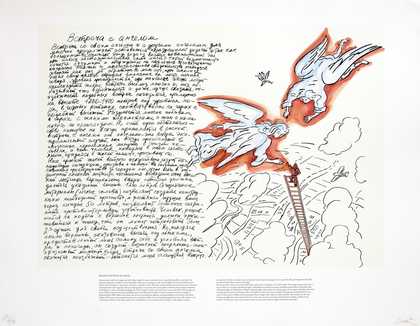
Ilya and Emilia Kabakov How to Meet an Angel 1998 Private Collection © Ilya and Emilia Kabakov
Photo Courtesy of the Artists
The theme of flight appears throughout the Kabakovs’ work. From the solitary flies in Ilya’s early paintings, it has been associated with the possibility of escape – whether from the oppression of the Soviet Union, or more generally from the harsh reality of life.
Spanning twenty years, the works in this room focus on the figure of the angel, an enduring symbol that has appeared throughout the history of art. For the Kabakovs, the angel is a stateless being that is free from earthly and bureaucratic constraints.
Following Ilya’s departure from the Soviet Union, the Kabakovs now live in New York State, and remain continuously active, developing new projects to be exhibited around the world. ‘Our life consists of our work, dreams and discussions’, Emilia Kabakov has said. ‘We are lucky: we manage to transform reality into fantasy and permanently stay there.’
